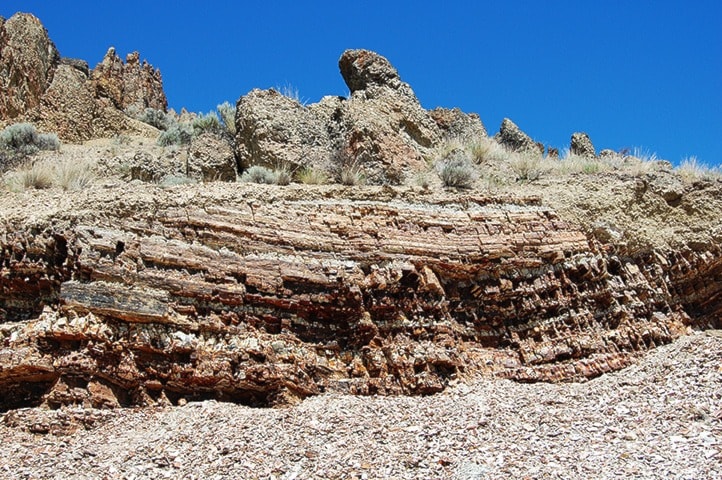If all goes according to plan, work will start at the McAbee Fossil Beds site east of Cache Creek this spring in order to have a “soft opening”, hopefully in the fall of 2017. The McAbee working group has received $48,000 in funding from the B.C./Canada 150 program to begin preliminary work at the site, which will include site mapping, digging a well, installing toilet facilities, and putting up a temporary shelter and picnic tables.
The McAbee site was taken over by the provincial government in July 2012 and declared a provincial heritage site. Since that time there has been a limited amount of research at the beds, but no general public access.
In early 2016 a group of people representing stakeholders in the area—including Cache Creek, Ashcroft, local First Nations, Walhachin, Gold Country Communities Society, TNRD Area “I”, Thompson Rivers University, Tourism Kamloops, the Royal B.C. Museum, Community Futures Sun Country, and the Heritage Branch of the Ministry of Forests, Lands, and Natural Resource Operations (FLNRO)—met to see what they could do to get the site reopened and developed. Following a series of meetings, the group of volunteers applied for—and received—funding to develop a business case and plan summary, which was completed in March 2017.
“The business case is to look at the sustainability of the site,” says Deb Arnott, a member of the working group and general manager of Community Futures Sun Country. “Our goal, our vision as a group is to have an interpretive building at the site, and have visitors come to the region. We wanted the business case to be a solid foundation that we could build on moving forward. I see this as a plan for 10 or 20 years to come.”
Having a solid business case will also help generate support for the plans for the site, adds Arnott; not just financial support, but support from stakeholders in the region and beyond. “We’re looking on this site as an economic driver and stimulus for our region,” says Arnott, adding that because of this, it will be important to keep things fresh there. “People cannot be coming back year after year and expecting the same thing, so we have to be really diverse.
“We want people to see things happening at the site each year if we’re going to continue drawing people to the site, whether it be locals, or people who live here who have family and visitors coming to their homes who they can take out there. We want them to be excited about the site, feel a part of it.”
ATW Associates Inc. prepared the business case, and Arnott says they purchased statistical data to ensure that their projected numbers were rock solid. A very conservative estimate shows that the McAbee site could, once the infrastructure and programs are in place, attract 50,000 visitors per year. However, to get to that point will take considerable financial support, which Arnott admits will be a challenge. That is one reason the business case stresses the long-term sustainability of McAbee.
“I’m quite excited about the business plan; it’s one of the best I’ve ever seen,” says Arnott. “Angela [from ATW Associates] got some really good data from her interviews with stakeholders. We wanted to know their vision, and if everyone has the same goal, and found that everyone is going in the same direction.”
Governance—specifically, forming a registered society—is the next step. “In my experience, the governance part is critical,” says Arnott. “Are we all on the same page with our vision and mission statements? It will be a very interesting process, and I’m not sure how everything will look in the next six or seven months. We have a very diverse set of people around that table.”
Of the work that is about to start at the site, Arnott feels the site plan is the most critical. “We need to plan where we will drill, where the washrooms will go, where the interpretive centre will go. People will take us seriously when they see some basic infrastructure in place.”

A beech leaf fossil from the McAbee beds. Photo by Wendy Coomber.
She adds that it’s important for the community to know that plans for the site are moving forward. “The community has heard for a long time about the site, but didn’t know what was going on. We couldn’t really talk about it, because we had to go through FLNRO. Now we can, since we have the business case.”
Activity will start at the site soon, and all the projects covered by the B.C./Canada 150 grant must be completed within five-and-a-half months. “That’s the latest we can go, but we hope to have things completed sooner,” says Arnott. “People can expect to see a lot happening at the site.” Meetings are being set up with area stakeholder groups, such as village councils and First Nations, so that members of the working group can talk about the business case and let people know what is happening.
Arrangements are also being made to bring paleoentomologist Dr. Bruce Archibald to the area before the end of May, to speak at public meetings about the site. Archibald has a long connection with, and deep knowledge of, the McAbee beds, and his lfirst public talk here, in December 2015, was very well-attended.
“Our goal for the site has always been to have an interpretive centre there,” says Arnott. “We envision three stages, and the soft opening this year will be the first stage.” The business case sets forth a 4,000-square foot interpretive centre in the second stage, which will expand to 11,000-square feet in the third.
“The business case is a reason for celebration,” says Arnott. “A lot of work has been done by the working group on zero budget. But we can’t see any reason why we can’t do this. We have so much support from everyone.”
